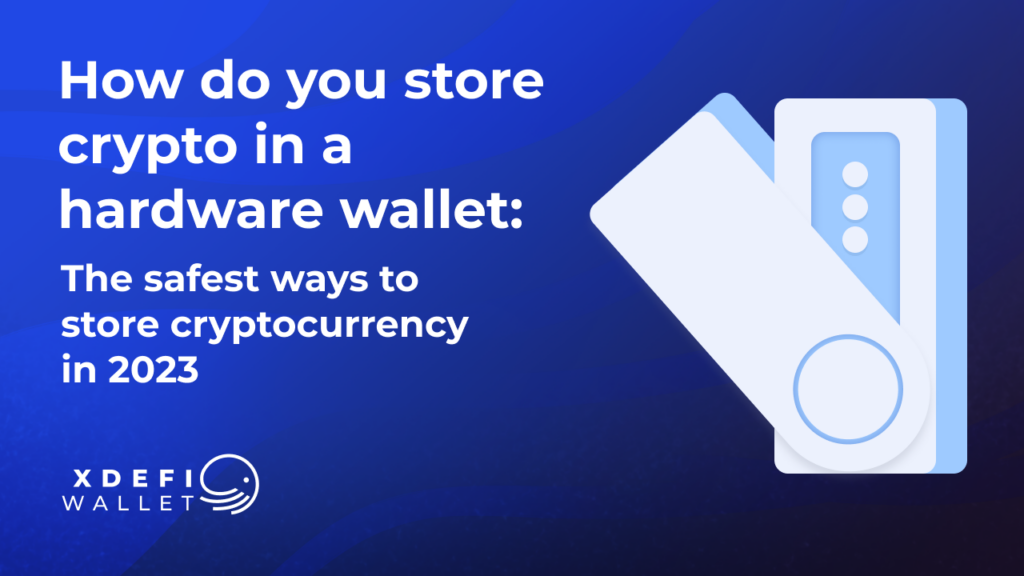How do you store crypto in a hardware wallet?
How do you store crypto in a hardware wallet: The safest ways to store cryptocurrency in 2023
2022 has been a challenging year for the entire crypto market and the overall Web3 community. Countless DeFi (Decentralised Finance) hacks and bankruptcies of reputable entities have shaken the confidence of crypto users, new and old.
How to keep one’s digital assets safe and secure has become the number one question for many, and rightfully so. As crypto wallets are the starting point for many crypto traders, NFT collectors and DeFi users, they are also paramount for the security of any stored crypto asset.
Storing digital assets in a hardware wallet which is not directly connected to the internet and doesn’t expose one’s private key to the outside seems to be the safest option. But how do they work, and what are the benefits? In the following article, we will provide you with a comprehensive overview of hardware wallets covering the following topics and questions:
- Storing private keys
- What is a crypto wallet?
- Can hardware wallets store any cryptocurrency?
- Advantages of storing crypto in a hardware wallet
- Disadvantages of storing crypto in a hardware wallet
- How to create a hardware wallet
- How to choose the right hardware wallet for you
- The best products to use
Storing private keys
The core function of any crypto wallet is to store private keys and abstract the usage of keys in a way that makes it more user-friendly for the owner. In crypto, private keys – a secret number – allow access to all funds stored on the blockchain, and they are also used to sign transactions and prove ownership of any blockchain address. In theory, the private keys can be secured by writing them on a paper called a paper wallet, keeping the private keys offline. Still, in practice, there are more user-friendly ways when making regular transactions via the blockchain.
Anyone who can get a user’s private key can get full access to the user’s data and funds stored on the blockchain. Therefore it is of paramount importance to keep the private key stored away and hidden from the public. Either in a hot wallet or cold wallet.
 In crypto, a private key is the central access gate to all user funds.
In crypto, a private key is the central access gate to all user funds.
As private keys are hard to remember, crypto wallets automatically create key pairs (there is a public key to each private key, used as a public address where funds can be received) and store them safely. When a transaction needs to get signed, the wallet asks the user for approval through better-known security models like passwords, two-factor authentication or facial recognition, improving the usability of interacting with the blockchain.
What is a crypto wallet?
Crypto or Web3 wallets not only store and manage private keys for the user safely and accessible, but they also allow users to send and receive cryptocurrencies like Bitcoin and Ethereum and get an overview of the digital assets stored on the respective blockchain address. They are also used to interact with decentralised apps (dApps), for example, within Decentralised Finance (DeFi), or send and store non-fungible tokens (NFTs).
There are different types of crypto wallets, which approach security in different ways, hot wallets, cold wallets and hardware wallets.
Paper wallets
Paper wallets are the simplest types of crypto wallets. Keys are written on a physical medium like paper and stored securely. As everything is stored offline, interacting with the blockchain is often cumbersome. Paper wallets also work with more secure and long-lasting steel plates.

Hot wallets
With hot wallets, also often referred to as online wallets or software wallets, private keys are stored within a mobile app, software application or web browser extension. Transacting and interacting with blockchain-based applications is typically very easy with hot wallets. Their constant connection with the internet poses a security risk.
Hardware wallets
Crypto hardware wallets (also called cold wallets) are a way to store digital money safely. They keep your money safe by storing them on a special device that isn’t connected to the internet. That way, no one can access your money without your permission. Still, hardware wallets can be connected to a computer to perform transactions on the blockchain.

Ledger hardware wallets are the most widely used cold wallets.
Can hardware wallets store any cryptocurrency?
In theory, hardware wallets can store any cryptocurrency. They use a combination of secure hardware and software to store and manage private keys so that users can securely store their funds. Hardware wallets are designed to be very secure and can support multiple types of cryptocurrency. This makes them a great choice for users who want to store multiple types of digital assets.
In practice, the hardware wallet’s firmware must support the respective blockchain of choice. Especially well-known providers such as Ledger or Trezor support dozens of blockchains and regularly extend their list of supported blockchains. Ledger hardware wallets, for example, currently support more than 5,500 crypto coins.
Advantages of storing cryptocurrency in a hardware wallet
One of the main advantages of storing cryptocurrency in a hardware wallet compared to other methods is the increased security since the private key is stored on the device rather than on a computer or mobile device.
Another advantage is that hardware wallets are resistant to computer viruses and malware, which means that your funds are safe even if your computer is infected. Another advantage is that hardware wallets are generally easier to use than software wallets. Furthermore, hardware wallets are generally more convenient than paper wallets since they are small and easily portable. Lastly, hardware wallets also provide additional features such as password protection and two-factor authentication, which can add an extra layer of security to your funds.
Disadvantages of storing cryptocurrency in a hardware wallet
Despite their many advantages, hardware wallets also have a few downsides. Hardware wallets are generally more expensive and less accessible than other forms of cryptocurrency storage. If the hardware wallet is damaged or lost, the cryptocurrency may be lost forever as there is no way to retrieve the private keys without the device, except if you stored your seed phrase separately, which is highly recommended. Hardware wallets require a certain level of technical knowledge to set up and use correctly. They can be difficult and expensive to replace, which could lead to a loss of funds if the device is lost or broken.
How to create a hardware wallet
Creating a crypto hardware wallet requires purchasing a dedicated hardware wallet device from a trusted manufacturer. Once you have the device, you can follow the manufacturer’s instructions to set it up and start using it to securely store your cryptocurrency. This process typically involves
- Download the wallet software and follow the instructions to set up your wallet.
- Write down and store your recovery seed phrase securely.
- Plug your wallet into your computer or mobile device.
- Follow the instructions to create a wallet address on the blockchain of your choice.
- Fund your wallet by sending cryptocurrency from an exchange or existing wallet.
How to choose the right hardware wallet for you
When choosing a hardware wallet, it is important to consider factors such as the type of cryptocurrency you intend to store, the security features offered, the ease of use, and the cost. Additionally, it is vital to research the company behind the hardware wallet to ensure that it is reputable and secure. Finally, read reviews from other users to better understand the wallet’s performance.
The best products to use
We generally recommend choosing a hardware wallet from a reputable company. Right now, both Ledger and Trezor are the providers of choice. We picked the favourite model of each vendor to have a closer look at.
Ledger Nano X
The Ledger Nano X is a hardware wallet designed to securely store cryptocurrency. It is a small device with a USB connection that can be connected to your computer or smartphone. The Nano X has a large touchscreen and can store up to 100 coins and tokens. It also offers a Bluetooth connection to use it on the go. The Ledger Live app can manage crypto assets and send and receive payments. The Ledger Nano X also has built-in security features such as a PIN code and recovery seed phrase.

The Ledger Nano X
Trezor Model T
The Trezor Model T is a secure hardware wallet respectively cold wallet that allows users to store their cryptocurrency securely. It has a touchscreen display and can also be used to manage multiple digital assets, sign transactions, and securely back up data. It is compatible with various cryptocurrencies and apps and includes advanced features like passphrase encryption, recovery seed storage, and two-factor authentication. It also supports multiple languages and is available on both desktop and mobile devices.

The Trezor Model T
In summary
Hardware wallets are essential to keep your crypto safe as they provide a physical device which stores private keys offline and away from the internet. This ensures the safety of users’ crypto assets from malicious actors, as the keys are not exposed to the internet. The physical device also makes it easier for users to keep their keys safe, as they are not stored online, and users can access their wallets without having to worry about their keys being stolen. Additionally, hardware wallets are built with secure elements, such as chips and embedded firmware, which provide extra security and make them more difficult to hack. Furthermore, these wallets provide users with a high level of control over their funds, as they are the only ones who have direct access to their keys.



